Our guide to Scandinavian events
Add a jazz festival, a world sporting championship or an extreme ski flying competition for extra sparkle on your holiday.
Our staff will respond to your query promptly and provide detailed information to your questions.
10 days - Let Norway live up to your expectations on this active adventure...
Take the less trodden path and experience the Norwegian fjords and mountains the active way. Warm up with a cycling trip along the famous Rallarvegen from Finse to Flåm. The construction route known as the ‘Rallarvegen’ is a 100-year-old man-built transport road designed for the conveyance of men and materials during the building phase of the most mountainous sector of the Oslo - Bergen Railway Line.
Each night, you will stay in boutique historic hotels with many lunches and dinners included.

As a Certified B Corporation, 50 Degrees North has designed this tour using handpicked local hoteliers and suppliers who share our ethos of delivering services and activities of high social and environmental standards.
The CO2-e per person per day of all tours is carefully measured following each season. We fully offset all emissions of our tours on your behalf, and we constantly look at ways to reduce emissions where possible.
Train, bike, local bus and fjord ferry.
International flights, lunches and dinners not detailed in the program and items of personal nature.
Arrive in Oslo and make your own way using the express airport train (19 mins) to your central hotel in the heart of Oslo. The Norwegian capital has a great deal to offer for the discerning traveller. If you arrive early, we can recommend a walk around the centre of town to view the Parliament, the Castle & the Harbour area.
Discover the new area of Bjorvika with the new Opera House and Munch Museum and then explore the charming shopping streets, cosy cafés and exciting eateries of Grünerløkka. After going shopping at numerous design boutiques, vintage shops and flea markets, head to the Mathallen food hall for local specialties. Lastly, visit the new National Museum of Norway down by the harbour before finding a spot in one of the local fish restaurants for dinner.
Uncover the spirit of Oslo on a three-hour walking tour that blends iconic sights with local secrets. Designed for both first-time visitors and curious returnees, this experience is more than a tour, it's a journey through Oslo’s stories, traditions, and modern-day life.
Led by a knowledgeable local guide, you'll explore highlights like the Royal Palace and the striking Oslo Opera House, while also venturing into hidden alleyways and artistic neighborhoods off the tourist trail. Along the way, you'll hear tales of Viking heritage, royal customs, contemporary architecture, and the city’s deep connection to nature and sustainability. It’s the perfect introduction to Oslo.
The afternoon is free for further exploring. We recommend visiting some of the Oslo highlights including the Kontiki & Fram museums, the Vigeland Sculpture Park, Ekerbergeparken and the Holmenkollen Ski Jump and Museum.
After going shopping at numerous design boutiques, vintage shops and flea markets, head to the Mathallen food hall for local specialties. Lastly, visit the new National Museum of Norway down by the harbour before finding a spot in one of the local fish restaurants for dinner.
Depart Oslo by train to the highest point on the Bergensbanen (Oslo to Bergen railway) at Finse; 1222 meters above sea level. At Finse you will disembark the train and stay at the mountain lodge for the night. If you take the morning train from Oslo you have time to enjoy Finse for local walks in the area. Finse is situated on the edge of Hardangervidda (the Hardanger Mountain Plateau) and offers great views of the Hardangerjøkulen (glacier).
Hardangervidda is one of Norway's most popular walking and trekking areas, and if you are an active walker we recommend to extend your stay at Finse for more extended walks in the area.
Overnight in Finse with Breakfast and Dinner
Finse is the place for variety of nature-based experiences and depending on your preferences you could spend the day hiking on the Hardangerjøkulen glacier with an experienced guide, or go for an independent hike in the area. The hikes vary from routes suited to families to strenuous all-day hikes straight from your mountain lodge. Activities are self guided. Overnight in Finse with Breakfast and Dinner.
After breakfast, you will pick up your bicycle at Finse and start the cycling trip along the railway construction road (Rallarvegen) to Myrdal and on to Flåm. The trip follows a well-maintained gravel road through the Hardangervidda. Take your time to enjoy the fabulous scenery, and if you are lucky you might even spot wild reindeer in the area. You will pass by the Fagervatn Lake, which is the highest point of Rallarvegen at 1310m. In the summertime, a café is run in the Fagernut Dwelling, where you can buy freshly made waffles and coffee. Your luggage will be transferred down to Flåm and will be waiting for you at the hotel.
The terrain is reasonably flat with some up and down between Finse and Myrdal (38km). Then at Myrdal you will take off towards Flåm and follow the very steep downhill switchback path to the bottom of the Flåm Valley. These last 20km from Myrdal to Flåm offer stunning views down the valley following the Flåm Railway. Doing the trip by bike allows you to plan a leisurely trip with lots of photo opportunities that those travelling by train will miss.
On reaching Flåm you will check into your local hotel. Make sure you keep your bikes for the afternoon in Flåm to do local bike rides.
If you are more of a walker than a cyclist you can chose to take the train between Finse and Myrdal, and then walk from Myrdal down the Flåm Valley to Flåm (20km) instead of biking.
If you travel as a party of 2 or more, and only one (or a few) of you want to do the active Norway in a Nutshell version, then we are more than happy to arrange those who do not want to bike to do the ’standard’ Norway in a Nutshell version of the itinerary. You will still be staying at the same hotels each night, and follow the same general itinerary, just using different modes of transport. Just ask us for details.
Accommodation and dinner at Flåmsbrygga.
After breakfast, join a fjord-safari through the stunning Aurlandsfjord and be prepared for an active day with light hiking and lunch at a local goat farm. In the evening, enjoy a delicious dinner at the restaurant and have a beer at the local microbrewery. Overnight and dinner at Flåmsbrygga.
The hike to the goat farm is only possible on ceratin days of the week.
Enjoy a free morning exploring Flam before leaving by ferry to Balestrand.
In Balestrand you will stay at the historical Kvikne's hotel where the Kvikne family have been the hosts since 1877. Now a modern hotel with all the comforts, the hotel still holds on to its special old-time character and also hosts an extensive collection of artworks and antiques worth a look. Dinner and overnight at the Kvikne's hotel.
After breakfast, join a cruise on the Fjaerland fjord, also known as "the green fjord" to Fjaerland passing tiny villages, waterfalls and steep mountains along the journey. From Fjaerland it is only a short bus drive to the Boyabreen glacier and the Norwegian Glacier Museum. Entry to the museum is included. After, return back to Balestrand and take the opportunity to explore the village and its surrounding by foot or by bike. Dinner and overnight at the Kvikne's hotel.
Take the morning or afternoon express boat out of the Sognefjord and south towards Bergen. With 5 - 6 hours on the water, you have plenty of time to soak in the atmosphere and the fresh air. There is a cafe on board with simple options. You can sit out on the deck on the upper floor with room to move. The boat moves pretty quickly and there are several stops along the way. Precipitous mountains, thunderous waterfalls and small homesteads that cling to the mountain sides are the framework of this boat tour.
Bergen is known as the "The Gateway to the Fjords of Norway" and it is a lively town with small-town charm and international feel. We recommend a walking tour via the famous fish market and along the Bryggen, the old Hanseatic wharf which is architecturally unique and listed on the UNESCO World Heritage list. Also worth a visit is the Fløibanen funicular which will take you to Mount Fløyen for the best views over the town. Overnight Bergen Børs Hotel or similar with breakfast.
All prices listed are per person, based on two people sharing a room. Prices are indicative.
Cycling can only be done from July onwards after snow has melted.
Please note that this trip can easily be shortened or lengthened. Call us for more options. For e.g we offer a 5 day Norway in a Nutshell with Cycling. This is just such a lovely place in the world to explore.
IMPORTANT NOTE: Weather conditions may occasionally affect certain activities, and as a result, the schedule may be adjusted to ensure the best possible experience for all guests. For multi-activity stays, often the order of the activities will be confirmed locally on arrival. Activities might vary slightly in their duration or location due to the weather and local conditions. Any activities that are unable to be re-scheduled due to weather conditions, will be refunded as a general practice, as determined by the activity provider.
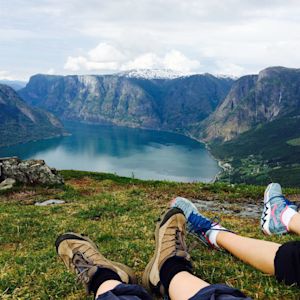
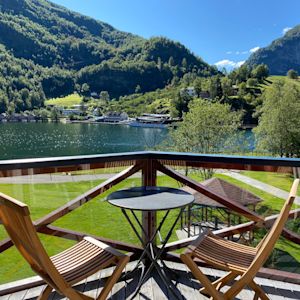

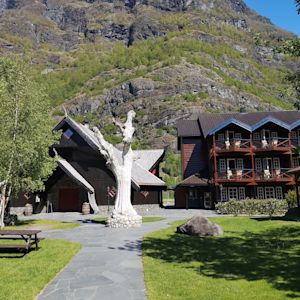
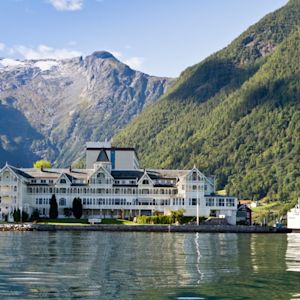

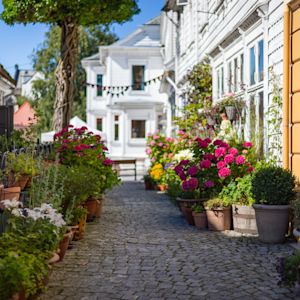
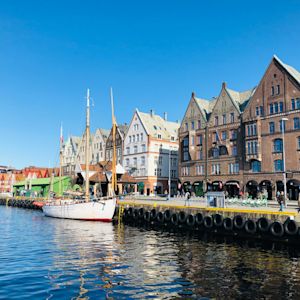
Add a jazz festival, a world sporting championship or an extreme ski flying competition for extra sparkle on your holiday.

Make sure to plan a visit to Oslo, the bustling capital of Norway, and pre-book a session with the floating sauna KOK Oslo. Our Nordic Destination Specialist, Ivy Thompson interviews Kirstin Lorange, founder of floating sauna, KOK Oslo.

Oslo restaurants, in the tradition of the New Nordic Food Movement, have the depth and sophistication you would expect from the capital city of Norway. Read our options for places to try.
Proper equipment is essential for hiking in the mountains. The weather can be unstable and may change quickly, so it is important to bring warm clothes, raingear as well as shorts. Mountain boots are recommended, and they should be well broken in. Bedding, dishes and cutlery are available at all lodges. A sleeping sack and towel are necessary for all tours. Correct packing requires good planning. Your backpack should not weigh more than 8-10 kilos. We suggest you bring the following clothes and hiking gear during your summer hiking in Norway.
Clothing
wool, part wool or synthetic underwear
wool socks/stockings
wind jacket/anorak or all-weather jacket
mountain trousers
shirt or light sweater of wool or fleece
boots
rucksack
In pack or pockets
rain jacket (if your jacket isn't all-weather)
rain trousers (if your trousers isn't all-weather)
cap/hat
scarf/neckband
gloves/mittens
sweater/jacket, wool or fleece
wool, part wool or synthetic long underwear
shorts
T-shirt
sleeping bag/sleeping liner
first aid kit
indoor footwear
extra underwear (trousers, shirt, socks)
extra indoor trousers (optional)
toiletries
towel
toilet paper
suntan cream
sunglasses
insect repellent
map and compass
map case (with pencil and paper)
knife
headlamp/flashlight
boot waterproofing
lunch packet
thermos or water bottle
emergency rations
money
Total weight: 7 - 12 kg.
For tent camping you also need
sleeping bag
sleeping pad
cook set and fuel
food
cup
plate and cutlery
tent
you can leave out a thermos
Total weight can easily be 15 - 20 kg for tenting
Other useful gear
binoculars
camera
"Til fots i Norge" guidebook
transport schedules
glasses
medicines
tickets
GPS
book(s)
candle
firestarter paper
multi-purpose tool
sitting pad
In forests you can get along with less gear and need not have the quality needed for mountain tours. The same applies to sheltered areas along the coast.
Spring and autumn can have winter weather in the mountains, so extra warm clothing is essential.
Pack light and don't take too much!
Travel insurance is compulsory for all tours with 50 Degrees North. The safety of our travellers, staff and operators is a major priority of 50 Degrees North. With an operational office in Norway, 50 Degrees North has access to an up-to-the-minute flow of information regarding the countries we work in. We are also in regular contact with the various operators we use. Their in-depth knowledge and understanding of their various areas is vital.
Norway has a few items that typically surprise travellers when visiting Norway for the first time. Alcohol and luxury items are heavily taxed and therefore prices are higher than you might expect. On the other hand, necessities such as bread and milk, are taxed low and therefore are great value.
We recommend that you bring all the alcohol you’re allowed to bring into the country when you arrive. There are many lovely parks and balconies where you can enjoy your duty free. However, be sure not to bring more than you’re allowed!
As of May 2014, the allowances according to Visit Norway are:
Alcoholic beverages:
Minimum age: 18/ 20*
1 litre of beverages with more than 22% up to and including 60% alcohol per volume as well as 1½ litre with more than 2.5% up to and including 22% alcohol per volume or three litres with more than 2.5% up to and including 22% alcohol per volume
and
2 litres of beer with more than 2.5 % or other beverages with more than 2.5% up to and including 4.7% alcohol per volume.
This means that you may for example bring with you five litres of beer provided you do not have any other alcoholic beverages with you.
*For importing alcoholic beverages with more than 22% alcohol per volume the minimum age is 20.
It’s illegal to bring extra alcohol into Norway and can end up costing you. Another thing you should bring and not buy in Norway is razor blades. Good razor blades in Norway are expensive.
Written by Jayde Kincaid, who married a Norwegian, and was happily (albeit with some hesitation) introduced to a world of Norwegian every day food habits.
At 50 Degrees North, we want to encourage our travellers to try local Norwegian food & drink. This may seem difficult in Scandinavia in general without a large budget, and in particular Norway. Some of the more remote villages you might visit have limited restaurants or cafes, some of which can be pretty expensive. There is certainly no street food! One way to get about sampling local food is by self-catering. You will find plenty of friendly locals in the small town grocery stores and supermarkets who will be happy to help you picking out local ingredients. Just don’t be shy – ask! And, don’t rush – make your local small town shopping part of your holiday experience. Read the local notice boards, and enjoy an ice cream out the front when you have finished. It is what the locals do!
Note: Statoil cups - a good idea to save money as you drive around Norway: purcahse a Statoil (petrol station) metal cup and you get free refills of coffee, tea and hot chocolate at the Statoil stations.
Norway has an extensive range of grocery stores, and in most small villages you will find at least one, if not two or three grocery stores. However, they do have limited opening hours, and except for ‘Bunnpris’, they are all closed on Sundays. You will see the weekend hours shown in brackets on the store sign out front. If you are arriving in a larger town, we do suggest you stock up with some staples before you head out into the mountains or on a coastal drive.
A few tips:
• Plastic bags are NOK1-2 and you will always need to pack your own shopping.
• You can recycle your bottles and cans for a receipt that you can cash in. Recycling points are found in all stores.
• Alcohol sold in food stores (mainly beer and cider) is restricted by government regulation to certain hours. This varies slightly, but on weekdays alcohol sales stop at 8pm regardless and on Saturdays at 6pm. Outside these hours and on Sundays you can only buy alcohol in licensed restaurants or bars.
• Any alcohol over 4.7% can only be bought at special government controlled liquor store (Vinmonopolet). These are very rare in smaller remote towns and villages, so stock up before you leave the city.
Meatballs or “meatcakes’: these come in all shapes, sizes and quality. They are generally really tasty and a bit better than what you find at IKEA. Also pick up a packet of dried ready-made brown sauce that goes with them. Be on the look out for Lingonberry sauce/jam, or even fresh lingonberries that you can use to make a fresh sauce (little red circular berries). Don’t add too much sugar, they are served quite tart.
If you want to try to make this brown sauce yourself, buy some ‘brunost’ (brown cheese), the required creams and follow the recipe below.
Hotdogs: known as ‘pølse’ in Norwegian, hot dogs are abundant in Norway. Cheap and cheerful – pølse is THE fast food of Norway. They are sold at service stations, newsagents, corner stores and fast food outlets. Pølse come with a dazzling variety of toppings and bread. Some of the pølse highlights would be the bacon wrapped ones, sprinkled with dried onion, mustards and mayonnaise. You will also find them wrapped in waffles (mostly in and around Fredrikstad) or the Norwegian pancake, ‘lompe’.
Note: there are strict requirements by the Food Safety commission for traditional pølse to be of the highest quality and they have even set requirements for what types of ingredients are allowed.
Like Norwegian beer, you will find seasonal pølse – Christmas pølse (Julepølse) is obviously found only in the lead up to the celebrations.
If you are planning to eat Norwegian style, use boil pølse on the stove and add to meals with potatoes and stew.
Note; steer away from tinned cheap pølse and meatballs.
Fish cakes: these also come in lots of variation and are generally served with a white sauce and lots of parsley. The Norwegians also use a basic white sauce on broccoli with cheese on top. These fish cakes are often found in fish shops, fried or steamed, ready to eat. A great fast snack.
Reindeer: we strongly suggest you try reindeer meat when you are travelling in the far north. It generally comes frozen, so look for finely cut reindeer meat in the freezer section. It is a more expensive option, but absolutely delicious albeit quite gamey. Be sure to get mushrooms, a small amount of brown cheese and rømme (crème fraiche). Fry it all up in a pan - a bit like a beef stroganoff. Serve with boiled potatoes or rice.
Mushrooms: if you are travelling in the chanterelle harvest season (mid/late August), be sure to try them. They are the yellow mushroom found in autumn. Or better still, have a look around the pine forests and pick some. Be sure to image search them before you head out so you know what to pick. They are really delicious with the brown cheese sauce and reindeer.
Salmon, prawns & fish: always be on the look out for a chance to buy fresh fish. Yes, it is possible to smooth talk a fisherman at the harbour. Or look for the local fish-kiosk or fish-shop. Be on the look out for small signs pointing you in the direction of fresh fish sales – ‘reker’ (shrimps, not prawns) or ‘fersk fisk’ (fresh fish) are the words you need.
Norwegians are very proud of their shrimps – and of course completely justified. Their shrimps are small and tasty and harvested from the cool North Sea. Norwegians traditionally serve them with mayonnaise and lemon. Peel them and pop them on a fresh white slice of bread. Mayonnaise is layered on top with dill, pepper & salt.
Smoked Salmon: Norwegian smoked salmon is the best in the world hands down. Be sure to try all the different varieties you see – often, in larger supermarkets or delis, you can try before you buy.
Tubed ‘kaviar’ (caviar): this is a must try. It is cheap and perfect for the travellers pantry. This is what my husband craves like an Australian abroad would crave vegemite.
Norwegian pre-made dips and salads: the Norwegian supermarkets have a large range of premade salads and dips. They last quite a while and are good fillers for sandwiches. Our favourite are the cubed beetroot salad and the potato salads. They come in easy-to-carry and pack-up containers – perfect for picnics. Tubed mayonnaise is also handy for picnics.
‘Leverpostei’ (liver pate) in many variations can also be found in the supermarket. This pate is normally served on brown bread then topped with sliced red onions or sweet pickles. Protein rich and very tasty if you like pate – it is found on most Norwegian breakfast tables.
Yoghurt: now – this is an interesting one. Norwegian yoghurt comes in a variety of styles - some can be very runny, sour and low fat. There are varying names/codes for each sort. You might like to check with a local when you are buying yoghurt to be sure you are getting what you want. Some of the yoghurt comes as though it is milk, in normal milk cartons - sour runny yoghurt is NOT nice in your coffee.
Bread: the Norwegian supermarket bread generally comes un-cut. You can either cut it in the shop – ask for help the first time you do it. They have industrial bread cutting machines near the bakery section. The bread can be quite plain in the main supermarkets so be on the look out for boutique bakeries in the larger towns if you enjoy fancy bread. Also keep an eye out for the Norwegian flatbread, Lefse, which is similar to Mexican tortillas. Usually served with butter and sugar, sometimes cinnamon too. Occasionally made with potato.
Waffles: Norwegian waffle stalls are similar to the sausage sizzle or hot dog stand. It is the most common fundraising or community building food product. Don’t expect sickly sweet jams or whipped cream – you will find these fresh chewy waffles served with sour cream and home made tart berry jams. Never go past one!
Chocolate: we recommend that you try the ‘FREIA’ milk chocolate during your stay. It melts in your mouth.
Berries: if you travel in early autumn (mid/late August) this is berry season. Forest berries that is. Ask a local and head up into the hills or forest in search for berries. You may find; blueberries, lingonberries, rasberries and if you are up north or in the central mountains; the rare yellow cloudberries.
On a self-drive journey, always be on the look out for small farm shops or stands along the road. Things you cannot drive past:
Strawberries: if you are travelling in the strawberry season – you MUST try Norwegian strawberries. They are seriously amazing. Grown in the nutritious earth that has the chance to rejuvenate through a long winter.
_And if you go past a self-pick strawberry farm, put everything else on hold and enter! Norwegians wait all year for this event. _
New potatoes: be on the look out for new season potatoes – they are often sold in little stands beside the road. Often on an honesty basis; i.e. grab a bag and put the money in an allocated tin.
CLASSIC RECIPE:
Basic Brown Cheese Recipe – can be used with meatballs, reindeer, with added mushrooms.
• 2 tablespoons butter
• 2 tablespoons flour
• 3⁄4 cup light cream
• 1⁄2 cup chicken broth (optional - just use water if you cannot find this)
• 1 cup shredded gjetost or brown goats cheese
• 3⁄4 cup rømme (crème fraiche)
• 2 tablespoons chopped parsley or 2 tablespoons fresh dill
Method:
Using the meat dish that has been browned off, remove as much oil from the pan as possible and blend in butter and flour. Remove from heat and blend in light cream. Add chicken broth, bring to boil, stirring and cooking until thickened. Mix in Gjetost cheese. Turn heat low.
Blend some of the sauce into the rømme (crème fraiche), then return all to sauce. Add chopped parsley or fresh dill.
Happy shopping and cooking!